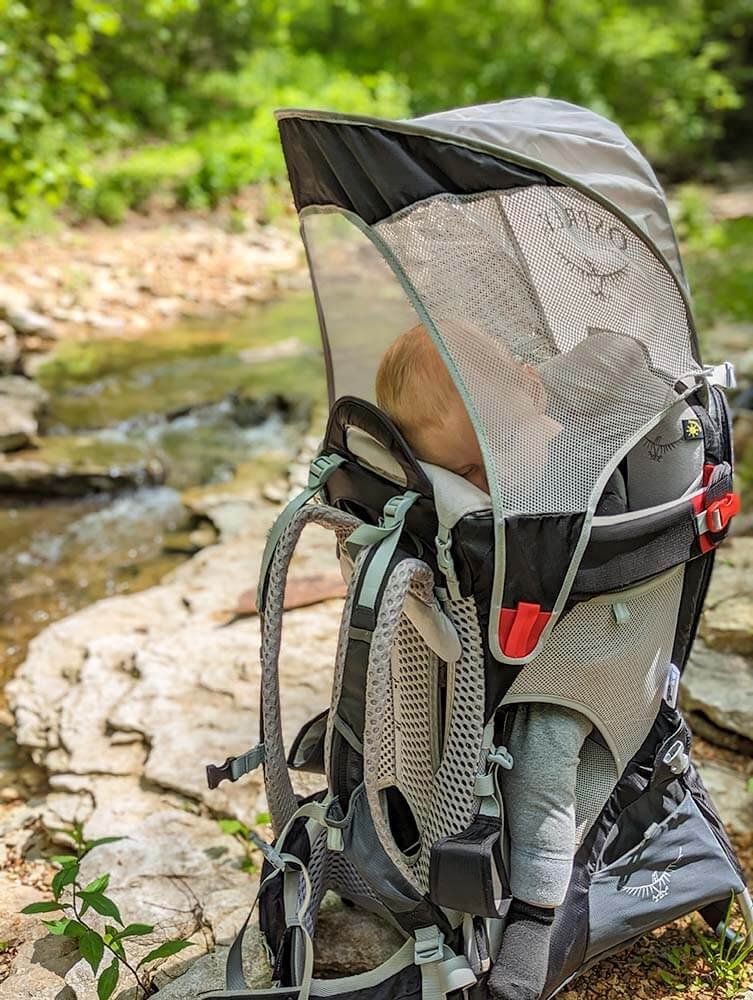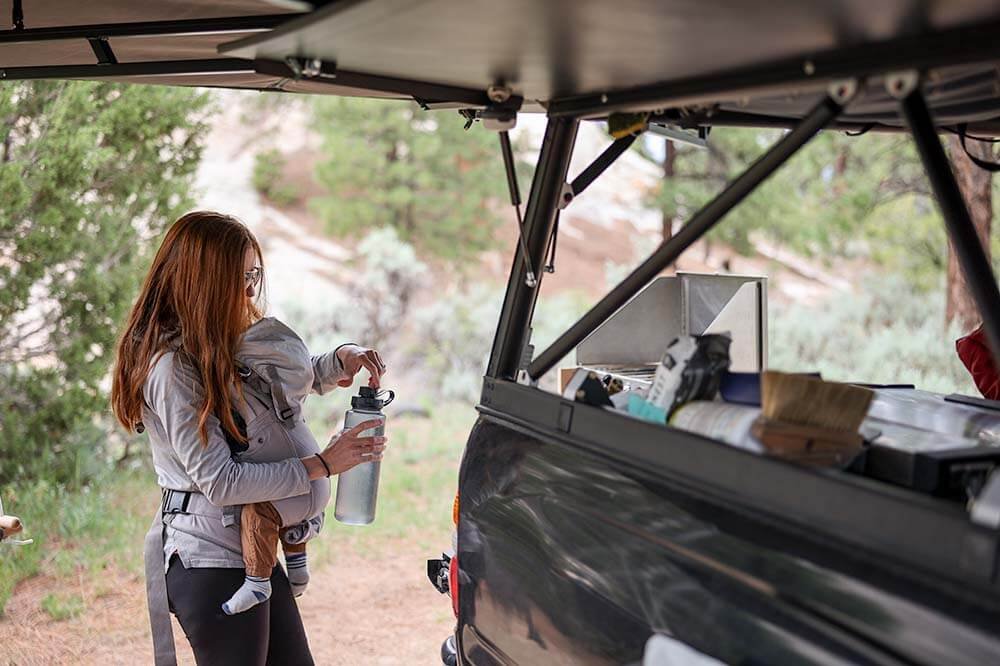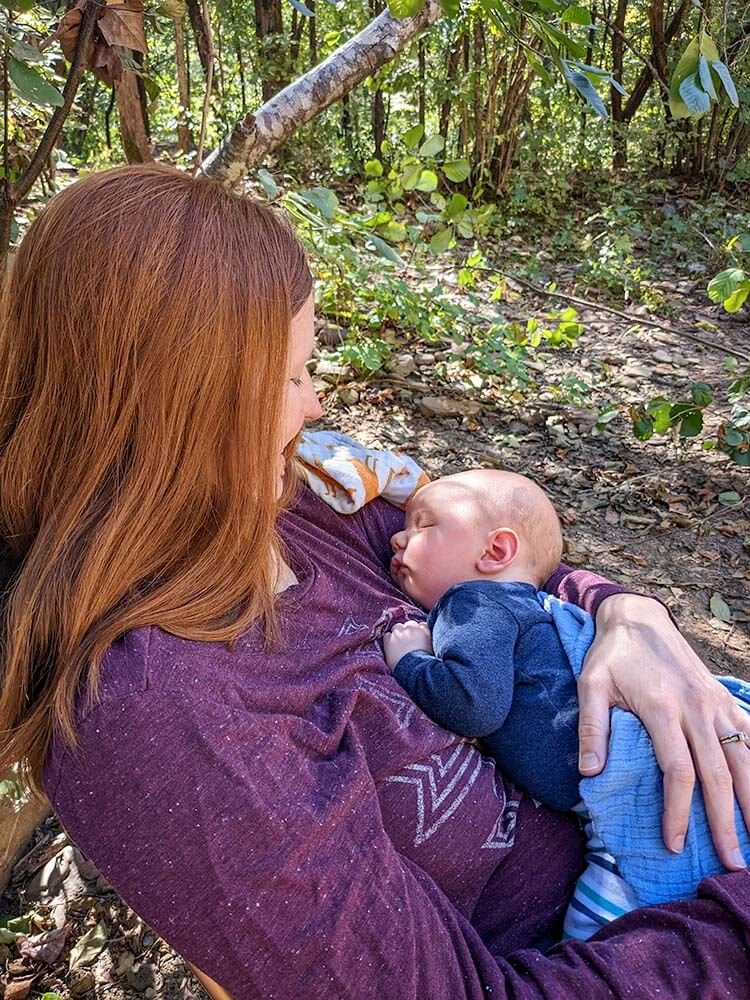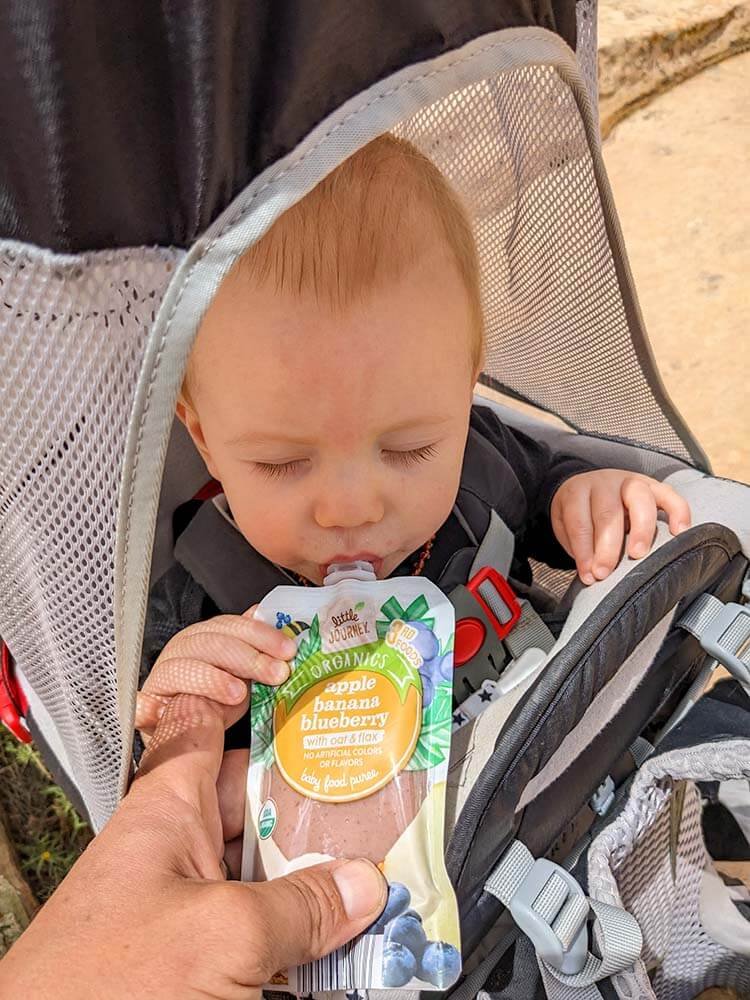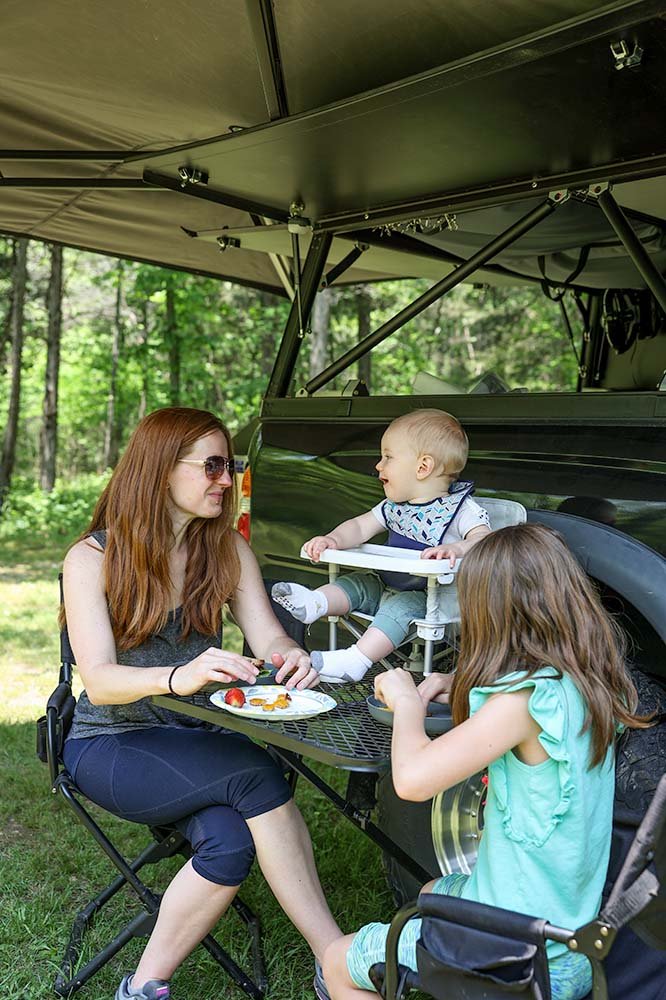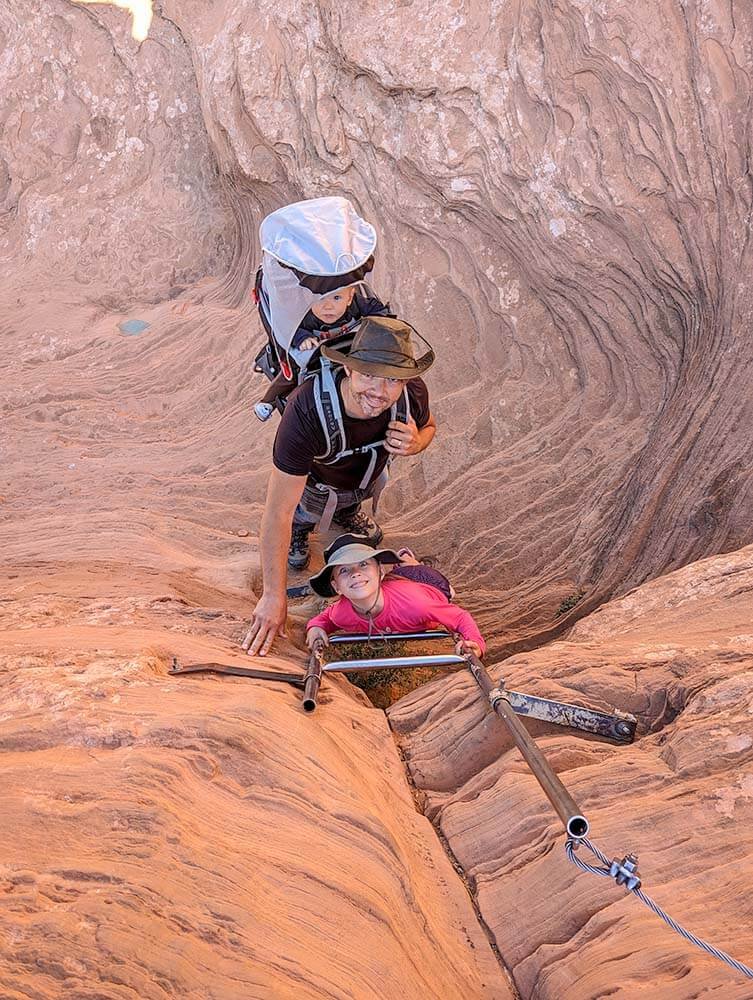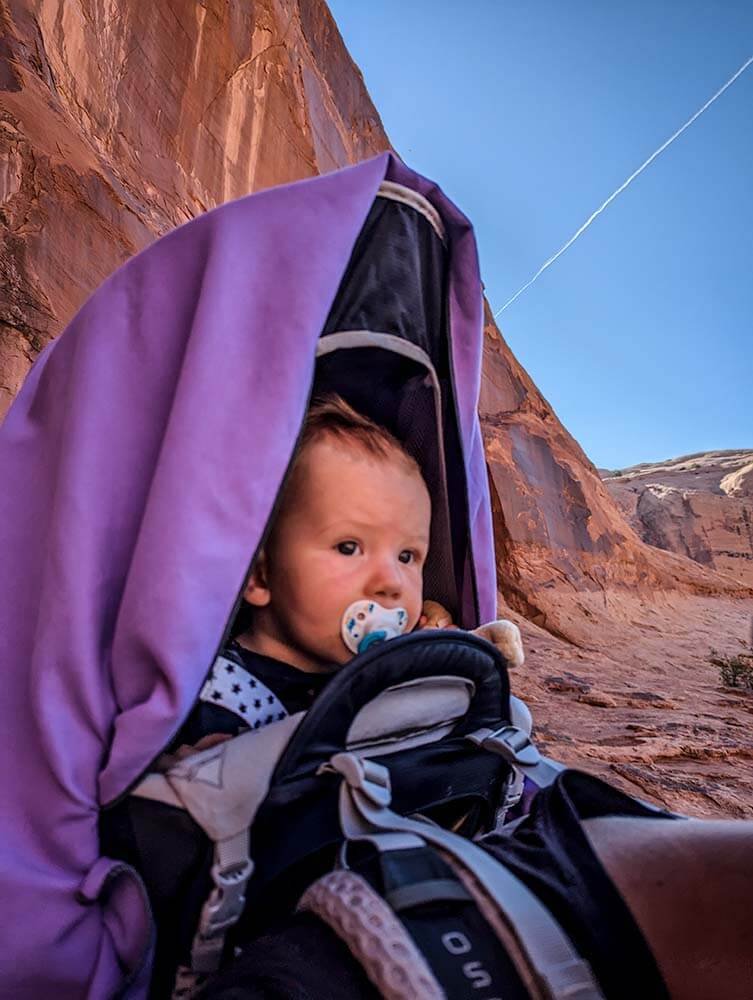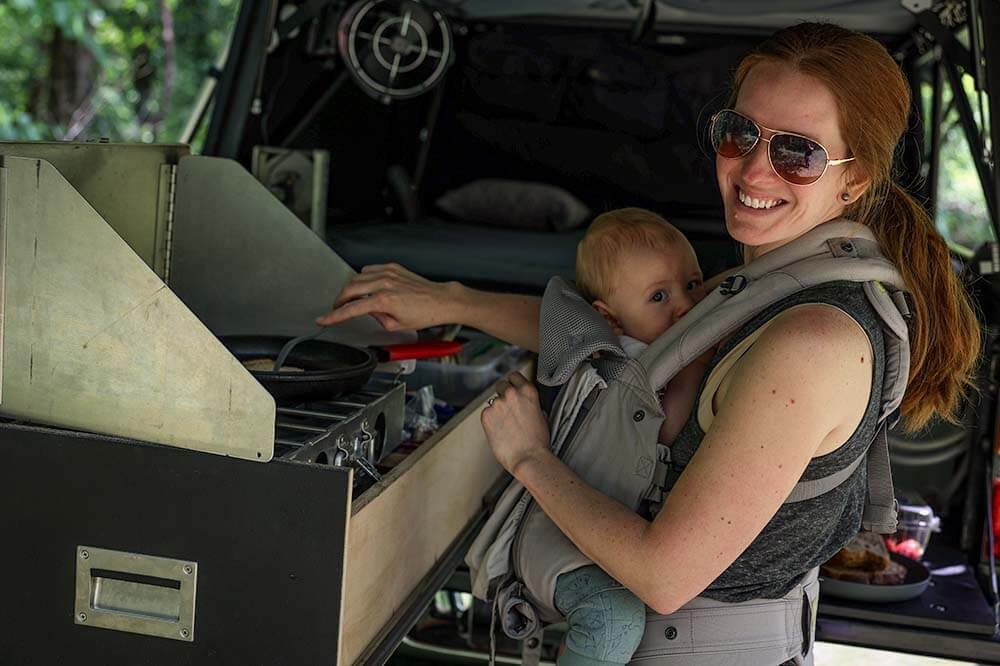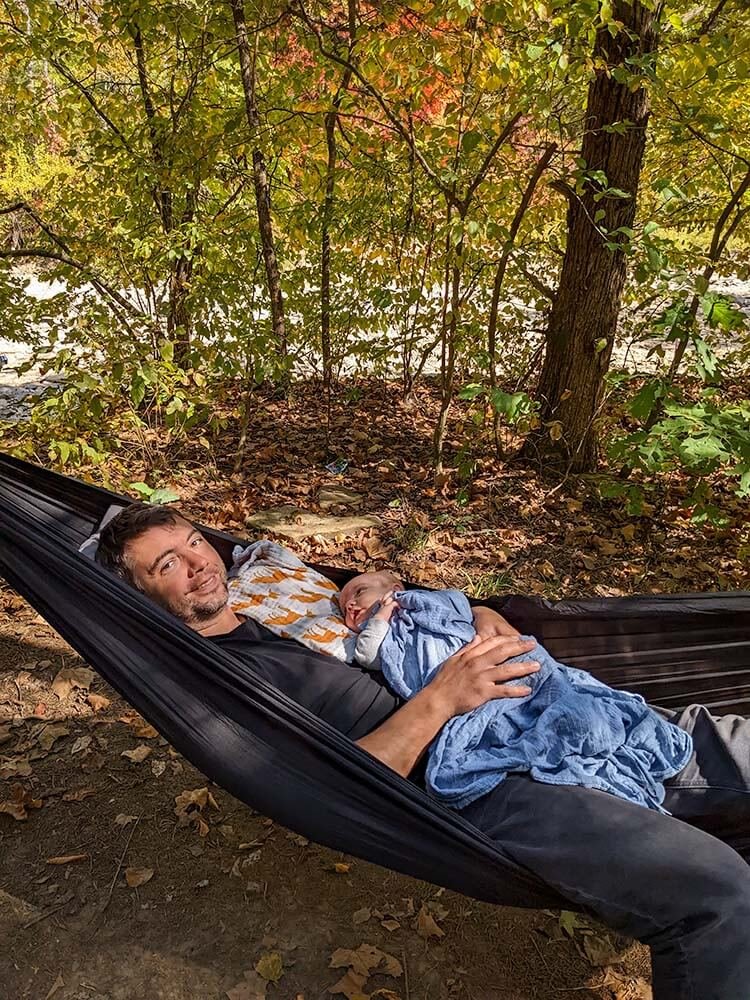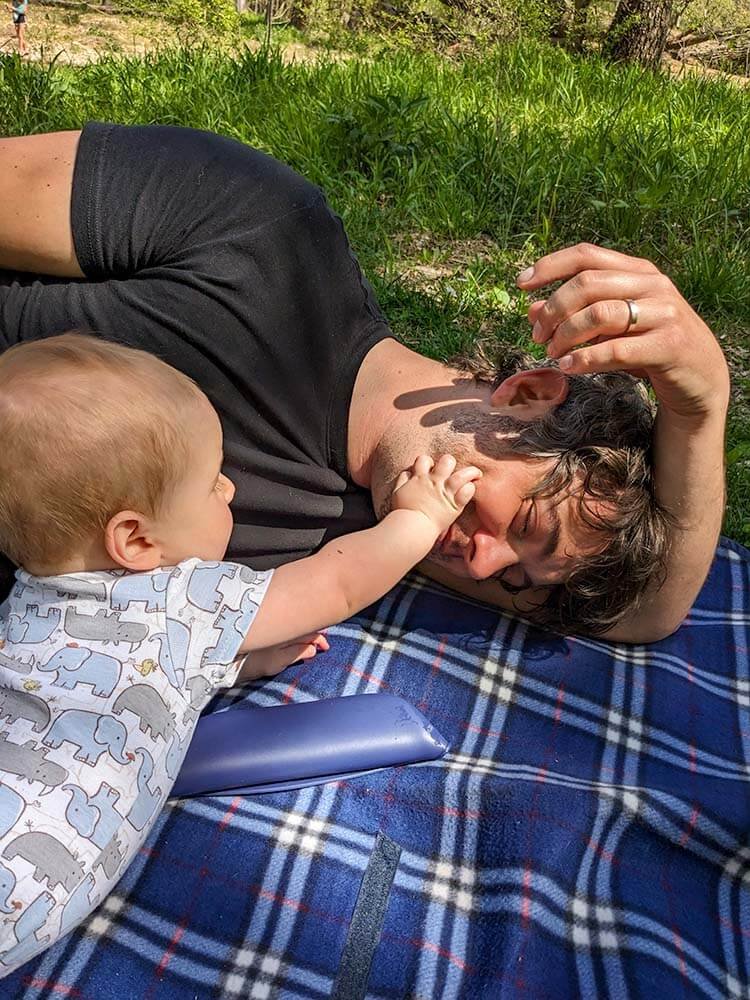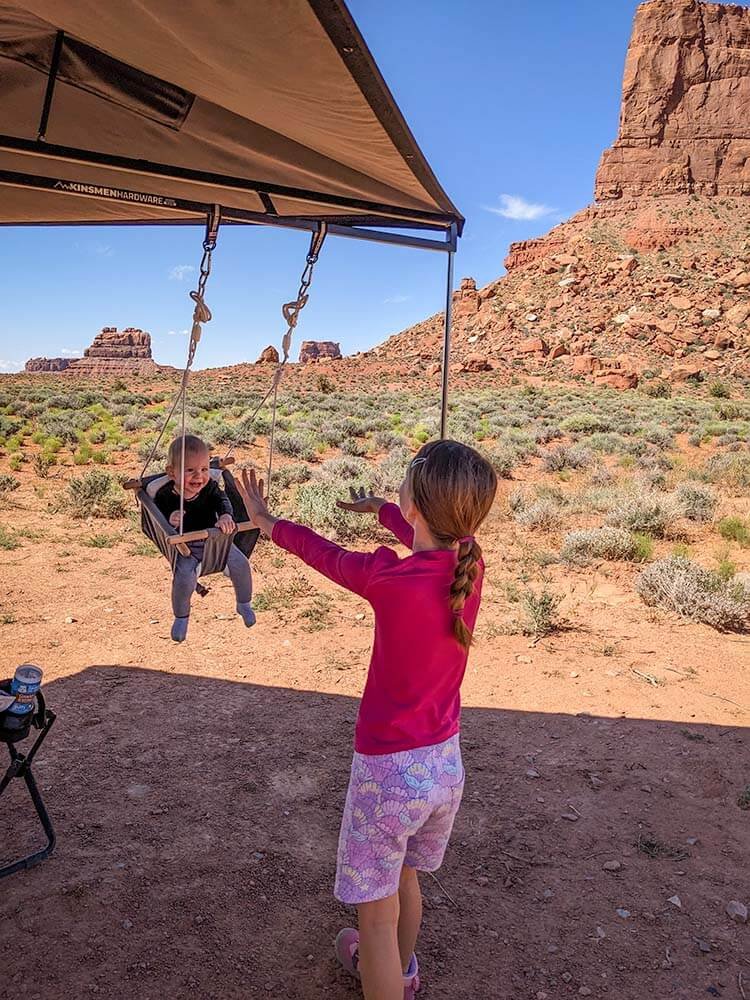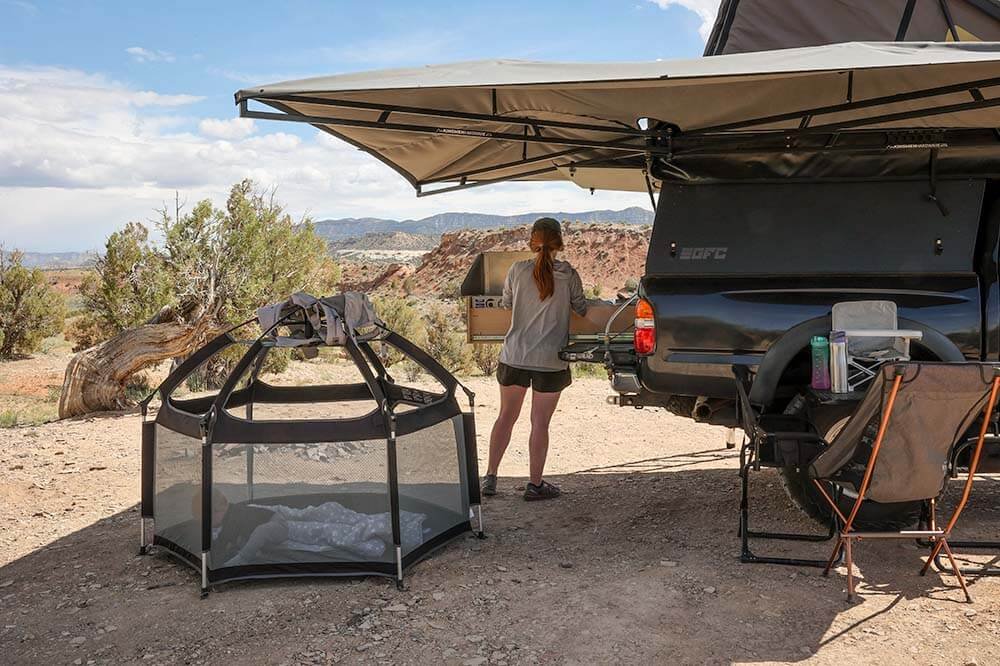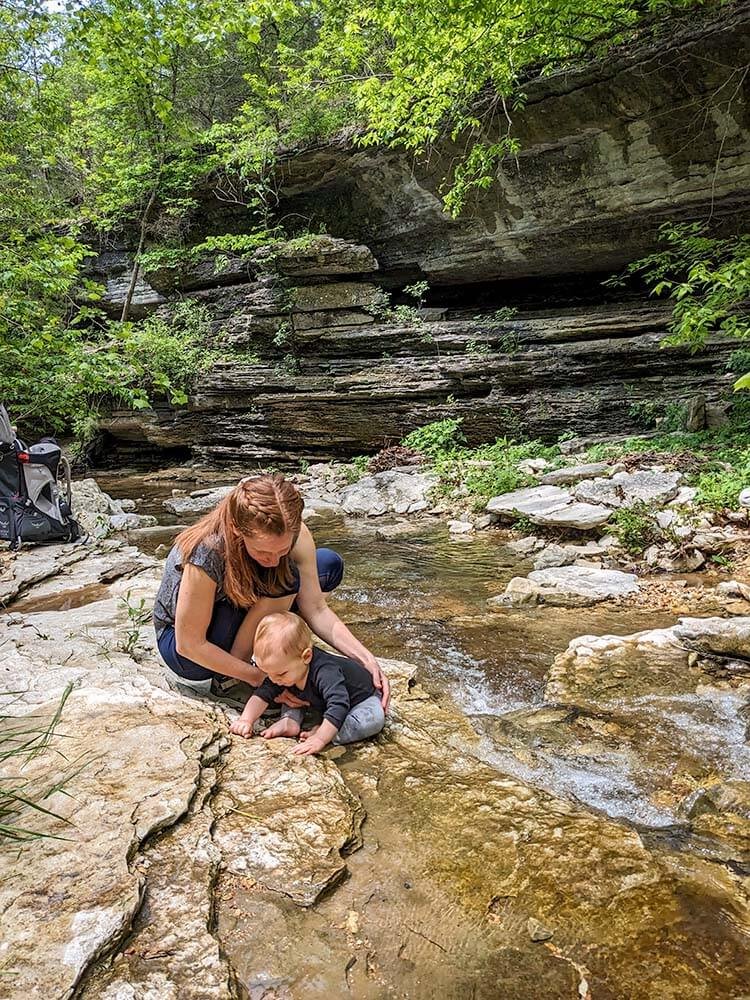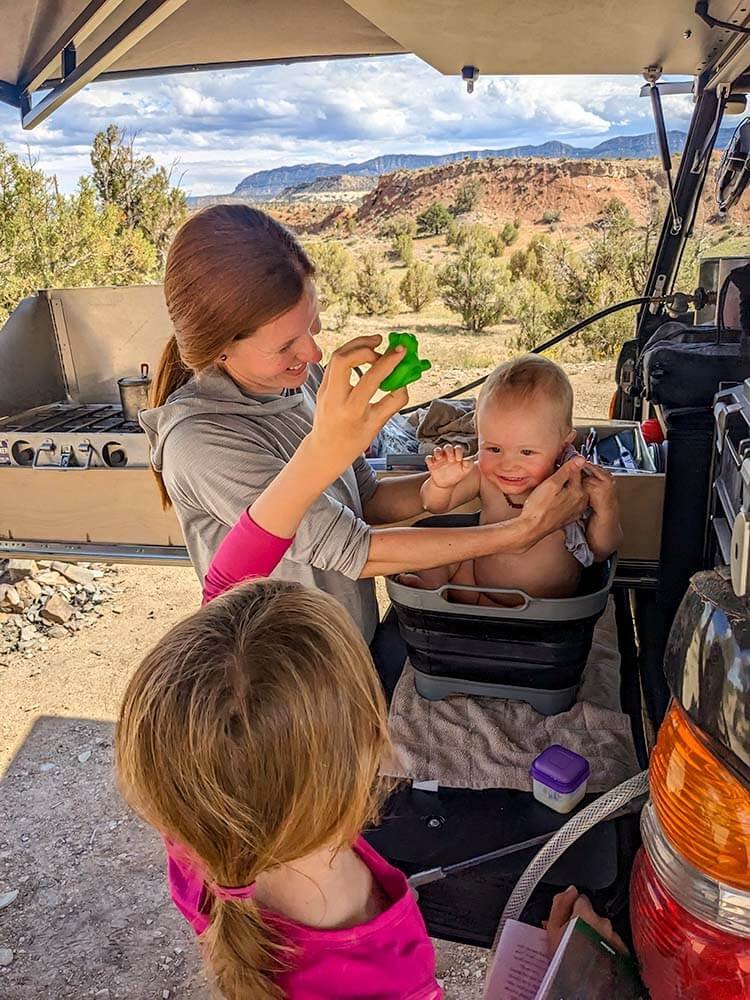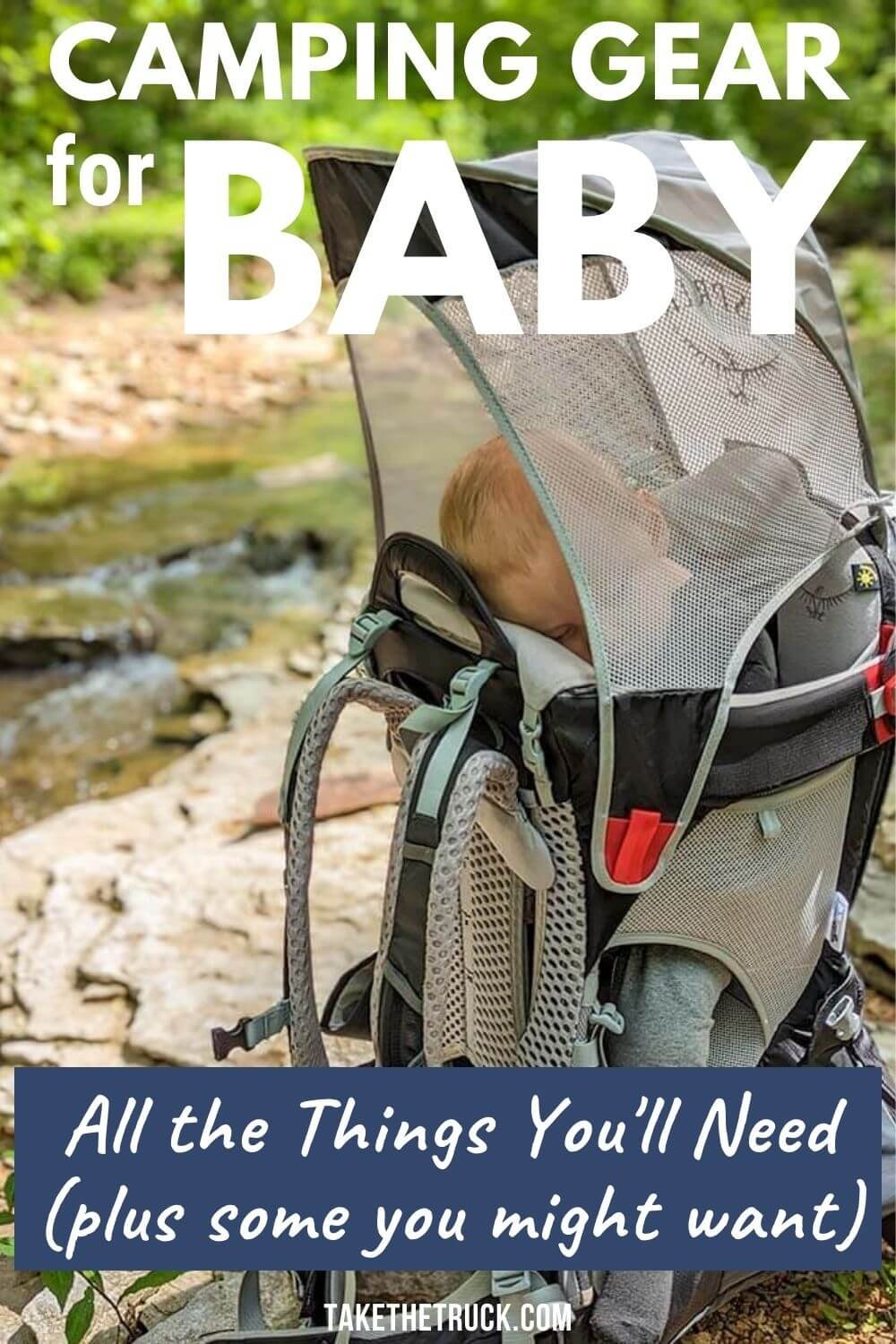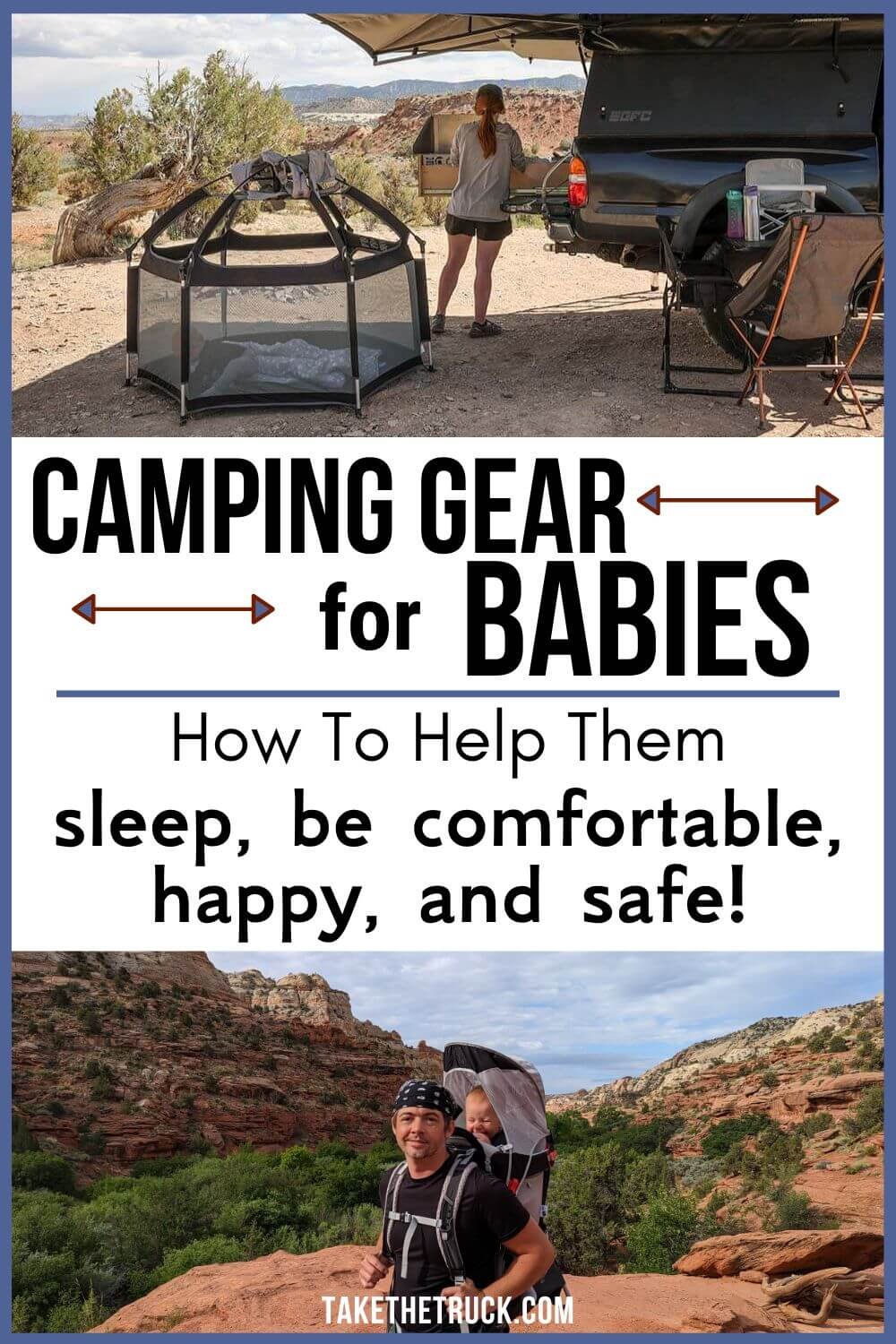Baby Camping Gear [60 Things to Make Camping with Baby Easier]
You’ll often hear people say to wait until your baby is older before you go camping with them. We disagree!
By including your little ones in camping and traveling rather than hitting the pause button on parts of life that you love, you can create family memories, experience new things together, foster a growing resilience when in less-than-comfortable situations, and instill a lasting love and appreciation for the outdoors.
Even with all those positives, there’s no denying that camping with a baby can feel stressful and intimidating! But, if you’re equipped with the right camping gear for babies it can be a truly fun and enjoyable way to share the outdoors with your growing family.
We started camping and traveling with both our children when they were around a month old - first with our daughter (almost 8 years ago) and more recently with our baby boy. It’s taken some practice, patience, forethought, and the right combination of baby camping gear to make our camping adventures a success.
So in this guide we’re covering all the baby camping gear you’ll need - some critical and some helpful extras - to help you:
Get Baby to Sleep
Keep Baby at the Right Temperature
Keep Baby Full and Hydrated
Entertain Baby (Not Always By Being in Your Arms!)
Keep Baby Clean (Enough)
Keep Baby Safe
*(This post contains affiliate links. This means we may receive a small commission, at no additional cost to you, if you make a purchase through a link. See our full disclosure.)
Baby Camping Gear for a Good Night’s Sleep
Let’s just jump right in with what’s usually the biggest question mark when camping with a baby: how to ensure your baby can get enough sleep. Because we all know what happens to the entire family if baby feels cranky.
Keep in mind that infants need different camping gear than older, more mobile babies. Infants tend to be easier when it comes to sleeping, because they’ll usually fall asleep just about anywhere and can be laid down without the fear of them waking up and getting into things. So, depending on the age and stage of your little one, here are some suggestions for sleep-related camping gear for babies.
Lovies, Pacifiers, Night Night Books, etc: Bring the same sleep helpers you use at home to keep that routine.
Portable Sound Machine: A sound machine* is especially important if you’re camping with baby in a busy campground or with older noisy kiddos who stay up later. Be sure your sound machine has a battery operated option (with good batteries!) or is able to be charged (and has a full charge!).
Portable Baby Monitor: We don’t find it necessary to have a monitor in with our baby camping gear, but there are situations where it would be super helpful. If you are camping in a louder campground where you may not easily hear your baby waking, or if you’re camping in a group and gathering together around the campfire a few sites over, having a reliable way to keep tabs on your baby would certainly make the weekend more relaxing. The monitor you use at home may not cut it if either end relies on being plugged into 110v power. The Roar Outdoor Monitor has a rechargeable battery with a super long life, relies on no wires for either the parent or child unit, and is designed for rugged outdoor use.
Dimmable Red Lights: You’ll want to be able to see your baby at night without a bright light waking him or her or attracting bugs. We’ve got dimmable red light options on our headlamps, and we also love these magnetic dimmable lights*.
Somewhere For Baby to Sleep at Night: Picking the right camping gear for baby to safely sleep at night is largely dependent on how you camp.
If you tent camp, don’t lay baby directly on the ground or on an air mattress because they can’t yet regulate their body temperatures.
You may end up buying a larger tent and bringing your bassinet or pack n’ play from home. Pack a fitted sheet that fits tightly across the top to block out bugs and some light and stimulation.
A portable bassinet/play area combo, like this one from Fisher-Price*, might be useful for a younger baby.
Look into travel beds if you camp and travel multiple times a year. The Kidco Peapod Travel Bed* is a great option. If you camp in cold weather and/or in a tent, consider using an extra sleeping pad under your baby to keep in the warmth, like the Therm-a Rest RidgeRest*.
If you have the space, these blackout pods* that slip over bassinets or pack n’ plays to keep light out of baby’s sleeping area would be especially nice in the summer months when the sun doesn’t set until 9pm!
Somewhere For Baby to Nap: Our nighttime sleep setup often doesn’t work for naps, and we’ve found that we rely on other baby camping gear to help get those much needed daytime zzz’s. It may be that we don’t have our tent opened up, or that it is too hot to nap there in the afternoons. Consider other places for napping if necessary. In a baby carrier, hiking backpack, carseat, hammock with a parent - you get the idea. Have some napping backup plans!
Wondering How To Dress Baby for Bed? Keep reading!
Baby Camping Gear to Keep Your Little One Comfortable
Not too hot, not too cold, but just right. Like Goldilocks!
Because babies can’t yet regulate their own body temperatures like adults, you’ll have to do the work for them. This can be done through the use of clothing and through heating and cooling the space around them.
Camping Clothing for Babies
Let’s start with clothing. Having the right clothing in your camping gear for babies can bring more peace and comfort, because you’ll know your littlest addition is protected from the elements - sun, wind, rain, plus some of the rocks and dirt.
This is especially important at night, so let’s look at how to dress your baby for bed.
Sleep Sacks and Sleeping Bags: Check out the nighttime temps before you pack. Keep in mind that it’ll be warmer when baby initially goes to sleep, dipping colder in the earliest morning hours. You may have to add a layer when you hit the sack, and cross your fingers that baby doesn’t wake in the process. Also consider whether or not you’ll be sharing body heat if you’re sleeping in close quarters and dress him or her appropriately.
Lightweight or Fleece sleep sacks as you’d use at home.
For approximately 55-65 degrees F, the Baby Deedee sleeping bag* for babies and toddlers is a good option.
Morrison Outdoors makes great wearable sleeping bags for babies over 6 months old with a 40 degree bag* (synthetic) and 20 degree bag* (down). These bags can be unzipped from the bottom up if baby needs to cool down. We love the hand cuff option and our baby has stayed roasty toasty in his ‘Little Mo’ bag.
With these options, you should be able to dress your baby in footie pajamas and call it a night. However, you may feel more comfortable having wool socks and a merino wool hat on hand too.
If it’s within your budget, grab a few basic merino wool items.
Merino Wool Hat/Balaclava - This wool balaclava* is a great way to keep baby warm while camping and comes in several sizes to fit properly so it’ll stay in place better! Have it pulled out when you get baby into bed at night, so you can easily layer him or her up if you wake up worrying in the night.
Merino Wool Base Layer - Having a good wool base layer* against baby’s skin will help with temperature regulation and air flow.
Merino Wool Socks - These wool baby socks* are great for camping or you could always stuff those baby feet into larger big kid socks for sleeping.
Check out these sites for some more great choices:
Or go here for a deep dive on merino wool for littles!
If you’ll be primarily packing camping clothes for baby from their existing wardrobe, here are some general tips:
Pack Extra: Pack more than you’d use at home because they’ll get dirty faster.
Pack Layers: Pack layers to help your baby stay comfortable while camping. The rule of thumb we’ve always gone by is to dress baby in one layer more than you’re comfortable in.
Pack Worn Out Things: Pack clothes that are already stained, about to be outgrown, or things that are not your favorite. And then don’t stress about the mess!
Mobile babies. So adorable, with their little army crawls and the way they waddle about. But while camping…whew! If/when you do plan to let them explore, check out these suggestions for keeping them safe and yourself sane.
Protective Clothing: If you’ve got a crawler or beginning walker who will be all over the ground, look into Baby Knee Pads* and Baby Rain Pants* to help protect those squishy legs and knees.
And of course, there are a few extra things to throw in with your baby camping gear, that you won’t know you need until you need them.
Sunglasses: You’ll want to buy baby sunglasses* before your trip and have baby practice wearing them.
Sun Hat: Grab one that velcros below the chin. If you don’t already have one you like, check out these Sunday Afternoon hats*.
Clothes Line: You’ll want a way to dry out baby things during your trip and this portable clothes line* is an easy way to do that.
Climate Control for Babies While Camping
Now onto climate control. Again, this looks so different depending on how you camp! For tips on keeping the whole family cool while camping in the summer, check out our post on How to Beat the Heat while Summer Camping!
Adding a fan to your baby camping gear can do wonders. Be sure you have it set up in a safe way and out of reach of little baby hands.
Handheld Fan: Grab a small rechargeable fan* to use throughout the day.
Vent Fan: In our original truck camping setup, we installed a rooftop vent fan and it did an amazing job of cooling the truck bed off, allowing our daughter to nap comfortably in the afternoon.
Rechargeable Fan: This Claymore rechargeable fan* is a great option for keeping air circulating in tents, campers, vans, trucks, etc. and comes with both a tripod stand and hanging loop.
12v Fan: We currently use the 7” Caframo Sirocco* fan in our truck camper because it works with our power supply and can be moved “upstairs” to the tent or “downstairs” to the truck bed easily.
For cold weather camping with babies, we typically opt for layering up and having appropriate sleeping bags over heating the sleeping space while camping. We find this is a safer and more consistent method for keeping baby warm.
But if you’re interested in other ways to keep baby warm while camping in colder temps, check out our Guide to Cold Weather Camping.
Meal Related Camping Gear for Babies
Being able to quickly and easily get food into your baby is another area that can make or break your camping trip!
If your baby is breastfeeding and hasn’t started solids, it doesn’t get any easier than that! Just make sure you have a comfortable camping chair for nursing, keep a few burp clothes nearby, and stay hydrated.
If you’re pumping, be sure you have a way to power your pump or bring a manual pump, and also have a way to clean and sanitize the pump and store your milk.
If you’re bottle feeding, you’ll need bottles and nipples, a way to warm the milk with either a travel bottle warmer* or an oversized mug to fill with boiling water to then set the bottle into, a way to clean the bottles effectively* with your preferred cleaner and a brush, and a place to dry them.
If your baby has started eating solids, obviously, you’ll need to pack food for him or her. When planning your own camping meals, make sure you’re including foods your baby can also eat and enjoy. Don’t plan to introduce new foods to your baby while roughing it in the wilderness, on the off chance of a negative reaction to the food.
Bring extra easy snacks when camping, that way baby can sit and enjoy an appetizer as dinner is prepared.
Camping High Chair: Most likely the highchair you use at home won’t work for camping. But, having your baby out of your arms and in a safe place to sit and feed themselves is essential to enjoying your own meals while camping.
We currently use this PandaEar Portable High Chair* because it’s compact and stores in a 15x16 bag. However, our baby is either on the ground (with a small tarp under him so he isn’t grabbing at dirt for dinner) or perched on our Tire Table - neither of which is super ideal. If you always camp in sites with picnic tables, this chair would be a great option.
The Baby Delight Go with Me Chair* and the Summer Pop n’ Sit* are both great alternatives and are our top considerations for eventually replacing the PandaEar Chair when space allows.
Food Related Utensils and Accessories: Keep it simple and use whatever you use at home
cups
utensils
silicone bibs* for easy cleaning
Wipes: Just… go ahead and bring all the wipes*!
Baby Camping Gear to Keep Baby Entertained
Depending on your baby’s age and mobility, keeping him or her entertained while camping will look different.
For Infants
Tiny ones are often happy in their carrier up against a parent, or laying on a blanket underneath a tree. Bring a few basic teethers, toys, and books from home. But otherwise, your infant will likely just want to be hanging with you.
For Mobile Babies
Carry That Baby!
While camping with a baby, you’ll most likely be wearing him or her more. So be sure you have a carrier that is fitted properly and is comfortable.
Carrier From Home: If you don’t camp often, are camping with a really young baby, only camp in cool temperatures, or don’t plan to hike extensively, just bringing your favorite carrier from home will likely be enough. You can always buy something more substantial (see below) if you continue camping as baby grows.
Hiking Backpack Carrier: We invested in the Osprey Poco Plus* and have used it for both of our kiddos. We use this for longer hikes and hot afternoon hiking (baby is not against a parent sharing body heat, plus there’s a built in sunshade). If baby falls asleep, it’s also super easy to remove while keeping your baby asleep and comfortable to finish the nap in a shady spot. The ClevrPlus Deluxe* baby carrier is a great alternative that’s a bit more budget-friendly. Pack along a thin towel or blanket and a way to attach it (think binder clips or safety pins) to the carrier’s sun shade to provide even more sun protection on longer hikes.
Stroller: Bringing your stroller from home may be a good option, especially if you’ll be camping in a more developed campground. Jogging strollers are better suited for the mixed terrains you’ll encounter while camping.
Wagon: If you have the space, have multiple children’s gear, and plan to be trekking back and forth between your campsite and the beach or playground, having a folding wagon* may be a real timesaver, especially if your baby is old enough to ride in it along with some of your other baby camping gear.
Play With That Baby!
Taking time to just lay and play with your baby while camping can create some really sweet moments and special memories.
Outdoor Blanket: Bring a large outdoor blanket* you can both lay on. Baby can have the space to do some rolling around out of the grass and dirt.
Hammock: Swinging together in a hammock* can be great fun and, if you play your cards right, may even lull your baby into a peaceful afternoon nap in your arms.
Baby Camping Toys: There are plenty of things for baby to play with while camping - large stones, sticks, bark from a tree - but because these things all require a bit of supervision, you’ll appreciate having a few favorites from home.
Teethers - Ideally ones that can be easily rinsed clean.
Nesting cups - Stack them, nest them, hide things under them, wear them like a hat, fill them with other toys, etc. We always bring nesting cups*!
Favorite Books - We’ve found that even younger babies find comfort in the routine of reading in a parent’s lap, as everything else about their day is new and unusual.
Toy Clips/Tethers - We never use these toy/pacifier clips* at home but they do get used every single day while camping. Keep those lovies attached during hikes and favorite teethers clipped up and out of the dirt!
Ditch That Baby!
You’ve carried your baby around, gotten all the cuddles, layed around on a blanket together, had all the instagram-worthy moments, and now, let’s be real, you’re kinda done for a bit. We recommend having multiple safe places to set your baby down where they can’t eat rocks and rub dirt into their eyes!
Pack n’ Play: This is the cheapest option (assuming you already own a pack n’ play) and works great if your space isn’t limited while camping. It may even double as your baby’s bed. Pull it out under the shade and throw a few toys in there.
Play Yard: We went for the Pop ‘n Go Premium* with Playmat* primarily because of how quick and easy it is to set up and put back away (under a minute!). If you don’t expect to need a sun shade, the best budget option we found is the Regalo Play Yard* (note it doesn’t come with a carrying bag either).
Camping Activity Center: If your babe enjoys sitting in activity centers and you camp or travel quite a bit, check out this fold up play center*.
Baby Camping Swing: Although it may not be suitable for some camp setups or sites, we wanted to share this idea in case it’ll work for you - because it’s been a real lifesaver for us! Our vehicle awning easily supports the weight of our baby in this canvas swing*, but the swing can just as easily be attached to a suitable tree limb at camp too. Just be sure to take into consideration the dynamic force/weight of your baby while they’re swinging, not just the static weight of your baby sitting in the swing, when selecting a suitable location for hanging the swing.
Highchair: Don’t forget about the highchair as an option for safely setting baby down while camping! Throw some toys or snacks on the tray and let your baby observe the world around them.
Water Play Baby Gear for Camping!
If you’re camping near water, be sure to add swim specific baby camping gear! The weather may not call for a full on swim with your babe, but sitting on the creekside together can open up a whole new world for your little one.
Long Sleeve Sunshirt: Protect that skin with rash guard swim shirts*!
Sunhat: Be sure it velcros under the chin.
Camping Towel for Baby: Being pulled out of chilly water requires a warm cuddle to dry off quickly! We’ve used these Sea-to-Summit Pocket Towels* for both of our babies while camping because they’re compact, comfortable for baby, and dry quickly.
Sunscreen: If your baby is old enough for sunscreen use, be sure to look into safer options for his or her skin, and don’t plan to use a sunscreen spray around your baby. Our favorite option is always to cover that skin with clothing and stay in the shade whenever possible!
Swim Diaper: We’ve used reusable swim diapers - both Thirsties and Beau and Belle* brands - with both kiddos because they are super cute and adjust up and down in sizes, meaning fewer purchases and less waste.
Water Shoes: Largely dependent on the mobility of your baby.
Water Floaty: In our experience, these floaties are fun* once baby is used to and comfortable with the idea of being in deep water.
Life Jacket: If you anticipate only needing a life vest for your baby a couple times throughout the year, these vests* are an effective budget option. But, many babies fight it if they are sausaged into a vest that rides up, pushing on their chin and not allowing them to reach their own faces. The Salus Bijoux Baby Vest* is a much more comfortable, although pricier, option for those who will spend a lot of time in the water.
Water Toys: Avoid toys that absorb water or have holes that fill with water. You don’t want your baby ingesting river or lake water when they inevitably bring the things up to their mouth.
Gear for you to be comfortable too: Make sure you’re comfortable too, because you won’t be able to walk away once you get set up at the water’s edge with baby. Grab a
Sunshirt for yourself
A cap
Sunglasses
Water shoes
A cushion for you to sit on* - so you aren’t hunched over your baby for an extended period of time (see photo - too old for that).
Baby Camping Gear for Keeping Clean (Enough)
All standards of cleanliness go down while camping, but you don’t want your baby to end up with a diaper rash or to be unprepared if he or she gets some bug bites or a runny nose.
Diapering
You know how many diapers you go through each day, so pack that, plus some extra. If you use cloth diapers, do yourself a favor and switch to disposables for your camping trip. I didn’t switch to disposables with our daughter, but do (7 years wiser) with our son, and I thank myself every single camping trip. Look into these eco and skin friendly diapers* if it’s within your budget.
Don’t forget a changing mat, your go-to rash cream, and bags for storing stinky diapers💩.
Bathing
If you’re camping for just a night, bring some extra wipes and hit the highlights. We like these water wipes*.
If you’ll be camping for more than a night or so, you’ll want a way to bathe your baby. Especially if you’ve been applying bug spray, sunscreen, or if your baby keeps taking dirt baths. We’ve been able to use our collapsible camping sink* for this, kinda doing a mix of a bath and a sponge bath.
Depending on the outside temperature, we sometimes heat some water to mix in with the bath too. For soap, we love Dr. Bronner’s Castile Soap* because it rinses off easily and is biodegradable.
Safety Camping Gear for Babies
Obviously, you’re going to have to stay on top of your baby as you pretend to give him freedom to roam and explore the world. Underdeveloped depth perception, no fear of cacti or strange dogs, the need to mouth on all objects, the list goes on!
But aside from having those safe places to set them down, covering their legs for crawling, and monitoring their “free play”, you’ll want to pack a few less obvious things in with your baby camping gear.
Bug Repellant: Depending on where and when you camp, bugs can make or break the camping trip. Here are the things we recommended to combat bugs, particularly mosquitoes.
Permethrin - Before camping, treat your tent, camp chairs, and other gear with permethrin*.
Thermacell MR300 Mosquito Repeller - This mosquito repeller* is great to have in your general camping area to keep the bugs at bay.
Sawyer Picaridin Bug Spray - We use this deet-free insect repellent* on our clothing and skin when necessary, and it’s super effective.
Baby Safe Bug Repellent - For your smallest family members, look into Babyganics Natural Bug Repellent*, or place a mosquito repellent patch* on your baby’s clothes. Insect Repellant Wipes* may be a good option if you don’t want to spray bug spray around your little one.
Shade: A vehicle awning (check out our in-depth Guide to Vehicle Awnings for camping), a tarp*, a portable canopy*, or umbrella will be much appreciated during the midday heat.
Sunscreen: If keeping your baby in the shade or covering their skin isn’t always an option, you’ll want some reliable sunscreen*. And don’t forget to protect your baby from those tricky sunburns that happen from reflected light off of water or sand.
Just in Case Gear: Hopefully you won’t need any special creams or medications, but you’ll be thankful you threw them in your stash of camping gear for babies if the need arises.
First Aid Kit - Know where your first aid kit* is and what’s in there!
Thermometer and Basic Medications - Just grab the age appropriate things you use most at home.
Skin Protectant - Being out in the elements may mess with your baby’s skin. Putting a thin layer of protectant* on your baby’s cheeks may prevent wind burn or excessive dryness. We’ve also used Aquaphor* for this purpose.
Teething Remedy - If you’re camping for more than a few nights, chances are, your baby will add popping a new tooth to the camping trip! We like Camalia*.
Topical Ointment for Skin - Unfortunately, surface scrapes, itchy poisonous plants, and mosquito bites* do happen, and you’ll want to be able to keep your baby comfortable.
Remember to Enjoy Your Time Camping With Your Baby!
Don’t forget to enjoy your time! Camping with a baby does add extra stress and work, but push through long enough to get to the payoff!
We’ve found the most challenging times are first thing in the morning and around the dinner hour. During those times, there’s typically more that has to get done (your own morning routine, making meals, helping other kids get ready for the day, doing camping dishes, etc).
Work with your spouse or partner as a team, taking shifts with your baby if he or she isn’t content in one of the independent play places, and push through. In another 30 minutes, the situation and scenario will be completely different, teeth will be brushed, bellies will be full again, dishes will be waiting for your spouse to do later, and everyone will be happy again!
A few tips to make camping with a baby easier:
Precook dinner at home so you just need to heat and eat. (Or check out these 60 Easy Camping Meals to help keep things simple).
Use paper plates.
Try to wake up before your baby so you can enjoy your morning routine.
Plan fewer activities and focus on just being present.
Drink more coffee! Check out our guide to 7 different ways to make camping coffee, pick one, and bring extra beans or grounds.
Bring something for yourself, like a book, fishing pole, journal, or a cold adult beverage. Use that naptime and post-bedtime to grab a little time for yourself to rejuvenate, and enjoy being out in nature too!
Don’t listen to the advice about waiting until your baby is older to go camping. If you want to camp now, then do it!
Use the camping gear for babies recommended in this guide, stay positive, know it will be different than camping used to be, and create your new kind of fun! We promise - the more you do it, the easier it gets!
Related Posts:
Pin This Post!
We’d Appreciate a Share!


